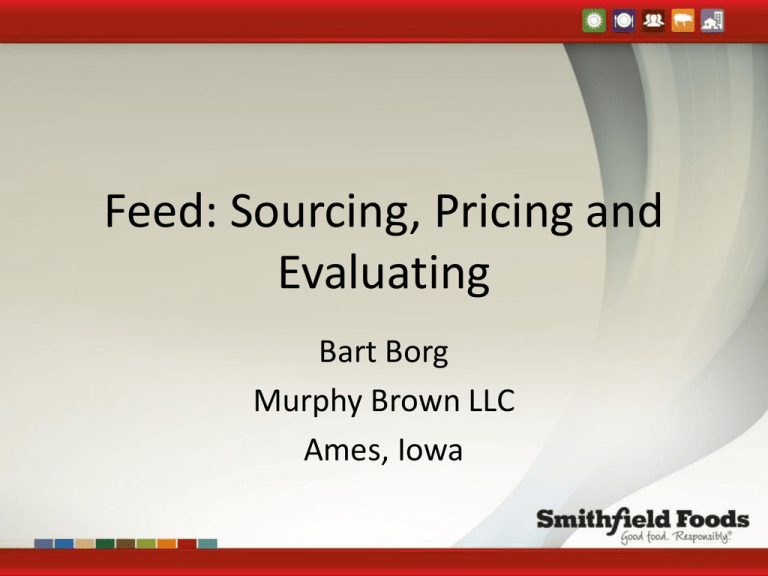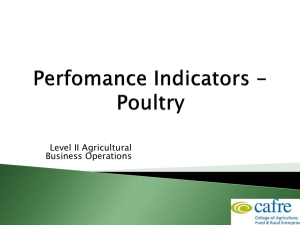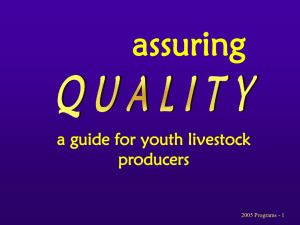
Feed: Sourcing, Pricing and
Evaluating
Bart Borg
Murphy Brown LLC
Ames, Iowa
Outline
• Shuanghui International purchase of Smithfield
Foods
• Key decision points for:
– Feed pricing
– Feed sourcing
– Feed quality and efficiency evaluation
• Wrap up
Transaction Overview
• On September 26, 2013, Smithfield became a whollyowned subsidiary of Shuanghui International Holdings
Limited, creating a leading, vertically integrated global
pork enterprise
• Smithfield will continue to operate as Smithfield Foods
and under its existing brand names
Who is Shuanghui?
• Shuanghui International Holdings Limited is a Hong
Kong-based holding company, which owns a variety of
businesses that include food and logistics
• Shuanghui International and its subsidiaries are the
majority shareholders of China’s largest meat processor,
Henan Shuanghui Investment & Development Co.
• Shuanghui began operating a single meat processing
plant in Luohe City, part of Henan Province, China, in
April of 1969
• Shuanghui International counts among its shareholders
CDH Investments, Goldman Sachs, New Horizon, Kerry
Group, and Temasek, as well as Shuanghui employees
and management
4
The Same Old Smithfield, But Better!
• No changes expected in how Smithfield does business
operationally in the U.S. and throughout the world
• Shuanghui is committed to maintaining Smithfield
operations, staff and management:
– Headquarters will remain in Smithfield, VA
– No closures at facilities and locations
– Management teams and workforces will continue in
place
• Smithfield will continue to work with the same U.S.
producers and suppliers
5
Who is
Shuanghui?
Partnership that is all about Growth
• China has 1.35 billion people, many of whom are moving rapidly into the
middle class and desire more and better-quality protein in their and their
family’s diets
• Pork is by far the leading protein in the Chinese diet, representing over 60
percent of all protein consumed
• Chinese consume more than 20 pounds more pork per capita per year than
Americans
• Over the last 15 years, Chinese per capita consumption has grown by 25
percent and US per capita consumption has shrunk by 10 percent
• Pork is the number three protein in the US, but the number one protein in
China
• China is responsible for 50 percent of the world’s pork consumption and their
demand is still growing, whereas pork demand in the US has been declining
for almost 15 years
7
Improving the Agricultural Environment
in US and China
• Growing exports is a key strategic objective for
this partnership
• Exports currently account for 30 percent of
Smithfield’s fresh pork revenue
• Exports are also critical to the US industry on a
whole
• China is the fastest-growing and largest overseas
market in terms of potential demand
8
Corn Harvest in Henan Province, China
50.0%
Source AgriStats, 2011
Aug-11
Jul-11
Jun-11
May-11
Apr-11
Mar-11
Feb-11
Jan-11
Dec-10
Nov-10
Oct-10
Sep-10
Aug-10
Jul-10
Jun-10
May-10
Apr-10
Mar-10
Feb-10
Jan-10
Dec-09
Nov-09
Oct-09
Sep-09
Aug-09
Jul-09
Jun-09
May-09
Apr-09
Mar-09
Feed as % of total costs
Feed: Largest Variable Cost
75.0%
70.0%
65.0%
60.0%
55.0%
Sensitivity Analysis – Hog Production
Feed Energy Content and Cost of
Production
Feed Energy Content
Average Daily Gain
Feed Conversion
Feed milling and transport capacity
Cost of Production
Routine Ingredient Price
Monitoring
• Important to bench mark alternative
ingredients to a standard (i.e. corn)
• Three scenarios:
– Seasonal ingredient price flux relative to cornmidds
– Little flux relative to corn – DDGS
– Opportunities in particular regions and significant
change over time - fat
Oil removal occurring across plants at a rapid rate
Feed Source Modeling Output
Feed Sourcing Considerations
• Unbundle the cost of feed delivered to the
farm
• Feed milling costs
– Pellets or mash; micron size of grain
• Feed transportation costs
• Feed ingredient costs
– Highly influenced by grain micron size
– Alternative ingredient opportunities
• The combination of the three is our eventual
cost of feed at each site
Feed Processing Opportunities
Grinding
• Reducing particle size of grain increases
surface area
• Improved digestion – improved feed
conversion
• Reduces diet costs to achieve the same dietary
energy content
ME Content of Corn with Differing Micron Size
4100
Kcal/kg, DM
4050
5% ME difference
4000
3950
3900
3850
3800
315
-- U of IL/Renessen, 2008
600
Micron size
Diet Cost per Ton at Various Corn Costs and
Micron Sizes *
Cost/pig fed would differ by
approximately $3.30/pig
Corn Cost, $/bu
Corn Micron Size
3.00
6.00
400
164.04
255.85
600
169.72
266.36
800
175.12
276.33
* Isocaloric diets using fat addition to standardize energy content and
fat prices held at 350% of corn
Milling Energy and Pellet Durability Across
Various Corn Micron Size
Micron Size
Pellet
durability, %
Milling energy,
Kwh/ton
Milling cost,
$/ton
Wondra et. al., 1992
Electricity at $.08/kwh
1,000
800
600
400
78.8
79.4
82.4
86.4
2.66
3.06
3.81
8.09
.213
.244
.306
.647
Evaluation of Pelleting
• Production considerations;
– Feed conversion impact or diet cost reduction
– Potential for improved ADG
– Mortality change with some genotypes??
– Opportunity to use increased amounts of
ingredients that may cause bulk density or flow
challenges
• Fine ground grain
• Alternative ingredients – bakery by-product, wheat
midds, etc.
Estimated net financial value is $12-13 per ton compared to mash
Effect of Diet Form on Finishing Feed Conversion
2.60
$2.60/ head opportunity
2.55
2.50
2.45
2.40
2.35
2.30
Meal
90% Pellets
70% Pellets
50% Pellets
30% Pellets
SEM = .05; Quadratic response P<.008
Murphy Brown LLC, 2003
--Stark, NC State, 2011
Feed Evaluation
• Nutrient content monitoring and validation
– Are you getting what you’re expecting
• Simple moisture, protein, fat and macro mineral
analysis
• Mycotoxin testing and monitoring
– Set maximum allowable mycotoxin specification
from the feed source and/or verify through
periodic testing
• Efficiency of use (i.e. feed conversion)
Projected Feed Cost Savings,
$ per market pig
Corn price, $/bushel*:
Feed efficiency improvement:
$5.00
$6.00
$7.00
6%
$ 4.12
$ 4.89
$ 5.66
8%
$ 5.50
$ 6.52
$ 7.55
10%
$ 6.87
$ 8.15
$ 9.44
*Assumes a constant price ratio of corn to SBM and fat
Feed Efficiency:
• Outcome metric not a lead indicator
• Marginal metric for effective benchmarking
• Requires extensive standardization adjustments
– Mortality
– Dietary nutrient levels (ME and AA density)
– Physical form
– Market weight
– Paylean use
– Place weight
Drivers of Feed Conversion Change
• Dietary energy/nutrient content
– Use of pellets or mash feed
– Grain micron size
- Enzymes??
• Lean deposition rate
– Sex
- Improvest
– Genetics
- Paylean
• Placement and sale weight
• Health status- livability
• When your plan for any of the above varies,
the outcome based Feed/Gain expectation
can vary tremendously.
Making Sense of Feed Conversion in a
Production System
Example of Standardized Feed Efficiency
• Plan
2.775
• Actual
2.718
Difference 0.057 better than plan
• Adjusted plan 2.685
Difference -0.033 worse than plan
Estimated cost variance $-0.36 per cwt
• The key is being able to define as much of the
variance of adjusted plan to actual as is
possible.
Average Daily Lactation Feed Intake
Weaned Pig Weight
Lactation Feed Conversion
Summary
• Feed sourcing decisions become much more clear
when the delivered to the farm cost is unbundled
into milling, delivery and ingredient costs.
• Monitoring key ingredients relative to corn can
help in identifying opportunity purchases.
• Grain micron size if a key driver in overall diet
digestibility and resulting costs.
• Many variables effect the feed conversion metric.
It is important to understand their individual
impacts and adjust expectations accordingly.







